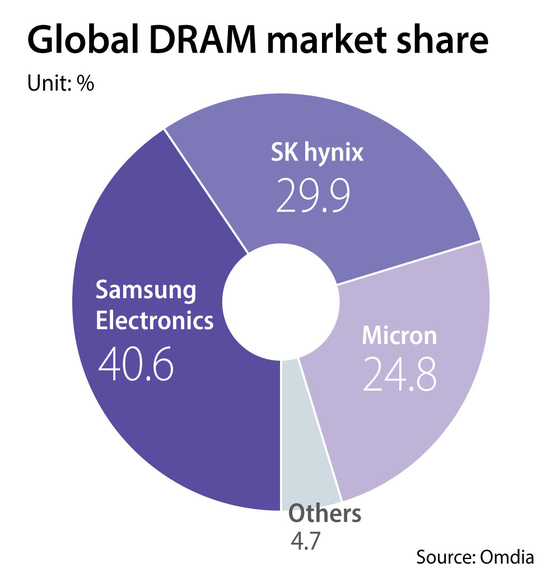Samsung Electronics losing billions of dollars on chips: Source
![Samsung Electronics' chip manufacturing complex in Hwaseong, Gyeonggi [YONHAP]](https://koreajoongangdaily.joins.com/data/photo/2023/03/02/7af7bdcd-fe69-4978-a365-d91656af5ab1.jpg)
Samsung Electronics' chip manufacturing complex in Hwaseong, Gyeonggi [YONHAP]
Samsung Electronics lost 3 trillion won ($2.3 billion) from its memory chip business in the first two months of the year, according to semiconductor industry sources, and losses could be even bigger for the full quarter.
The Suwon, Gyeonggi-based chipmaker estimates that the operating loss could balloon to 4 trillion won by the end of the first quarter as the market downturn has continued into 2023.
“Internally, there was a report projecting up to 4 trillion won in operating losses from the memory chip business in the first quarter,” one of the sources said.
It would be the first loss for the division since the fourth quarter of 2008 when the world was reeling from an economic crisis sparked by the bankruptcy of Lehman Brothers.
“Its semiconductor division has a foundry business that makes a profit, but the contract chipmaking segment is not big enough to lessen the massive losses from the memory business. At least 2 trillion won of loss for the Device Solution (DS) division is inevitable,” the source said.
The DS division has been considered the crown jewel of the electronics maker as it generated the most profit until the steep price decline of semiconductors hit the company hard at the end of last year. Other businesses include smartphones, consumer electronics and displays.
Last year, the chip division brought in 23.8 trillion won of operating profit out of the company's 43.4 trillion won. On a quarterly basis, the division’s operating profit came in at 8.5 trillion won in the first three months, 9.9 trillion won in the second and 5.12 trillion won in the third.
Things turn dramatically bleak in the fourth quarter as the division posted a 270 billion won operating profit, down 97 percent on year.
The Samsung Electronics semiconductor division reported operating losses of less than 1 trillion won in quarters in 2008 and 2001.
But this time around, the loss is more daunting as prices of dynamic random-access memory (DRAM) and NAND flash chips have declined sharply.
Average contract prices for 8 gigabyte DDR4, the benchmark DRAM, stood at $1.81 last month, a quarter of the average price four years ago.
Market tracker TrendForce projects that DRAM prices will likely slide 20 percent in the first quarter and another 11 percent in the second quarter, while those of NAND flash chips will go down 10 percent in the first quarter and 3 percent in the second. DRAM prices fell 34 percent in the second half of last year.

With reduced profitability, Samsung Electronics borrowed 20 trillion won from Samsung Display, a subsidiary, to help in the funding of semiconductor investments.
“The move was inevitable given that its cash cow DS division is expected to suffer a loss for the first time in 15 years and overseas subsidiaries have most of the company's cash reserves,” said Jeff Kim, an analyst at KB Securities.
The electronics maker has said that it will maintain this year a similar level of capital expenditure as last year without any plan to "artificially" cut back production of semiconductors.
Sourcing funds locally was critical since “most of the 53 trillion-won capex planned for this year is committed to domestic operations,” according to Kim.
Even if the memory chip division incurs trillions of won of losses, the overall balance will remain in the black due to its dominance in smartphones and appliances.
That is not the case for SK hynix, where over 90 percent of sales come from memory chips.
Analysts forecast an operating loss of 2.7 trillion won in the first quarter for the world’s second largest memory chipmaker, according to market tracker FnGuide.
The Icheon, Gyeonggi-based producer logged an operating loss of 1.7 trillion won in the fourth quarter last year compared with a profit of 4.21 trillion won a year ago.
Some experts call for the focus on high-end products as they are less affected by the steep decline in prices.
“Now is the time where chipmakers pull resources for the development of high-performing memory products,” said Park Jae-gun, an electronic engineering professor at Hanyang University.
BY LEE HEE-KWON, PARK EUN-JEE [park.eunjee@joongang.co.kr]










with the Korea JoongAng Daily
To write comments, please log in to one of the accounts.
Standards Board Policy (0/250자)